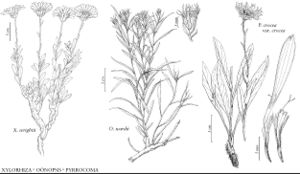Xylorhiza wrightii
Pittonia 3: 47. 1896.
Common names: Big Bend woody-aster
Illustrated
Basionym: Aster wrightii A. Gray Smithsonian Contr. Knowl. 5(6): 75. 1853
Synonyms: Machaeranthera wrightii (A. Gray) Cronquist & D. D. Keck
Subshrubs or perennials, (15–)20–40(–54) cm. Stems branched mostly in proximal 3/4, glabrous, densely stipitate-glandular. Leaf blades spatulate to obovate or oblong, rarely elliptic, 5–24 mm wide, bases attenuate, not clasping, margins flat, toothed to entire (densely short-ciliate), faces densely stipitate-glandular, otherwise glabrous. Peduncles 5–10 cm. Involucres (20–)25–35(–40) × (20–)28–40(–48) mm. Ray florets (18–)24–32(–34); corollas usually light blue to purple, rarely white. Style-branch appendages equaling or shorter than stigmatic lines. 2n = 12.
Phenology: Flowering Mar–May.
Habitat: Barren areas, alkaline, rocky-clay soil, gypsum or limestone flats, shaly slopes, rocky hills, dominated by saltbush, creosote bush, catclaw, and yucca
Elevation: 700–1100 m
Distribution
Loading map...

Tex., Mexico (Chihuahua).
Discussion
Selected References
None.
Lower Taxa
None.
